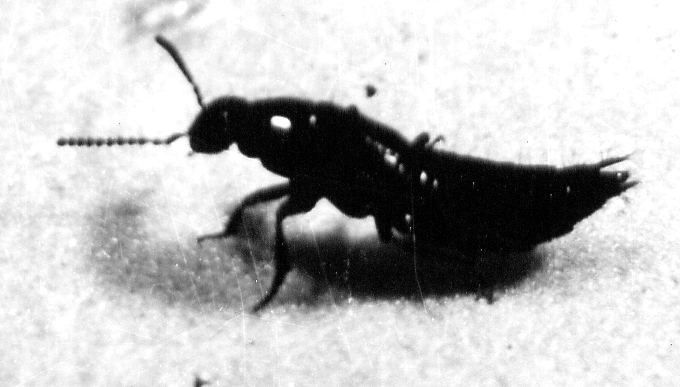|
Atheta (Atheta coriaria Kraatz) Rove Beetle
Fly Egg, Larva Predator
Atheta is a native species of soil-dwelling rove beetle which feeds on small insects and mites (e.g., shore flies, fungus gnats, moth flies, springtails, root mealybug crawlers, aphids, spider mites).
- Both adults and larvae are active aggressive predators and are attracted to decomposing plant or animal material and algae where their hosts are found.
- They are light to dark brown in color; adults are 3-4 mm long and are slender with short wing covers. Rove beetles have an interesting habit of curving the abdomen upwards like scorpions and can run or fly when disturbed.
- Since they actively fly, they rapidly colonize the release area.

Atheta or rove beetle attacks fungus gnat, cabbage root and onion root maggots in the soil.
Target Pests:
Shore flies (Ephydridae)
Fungus gnats (Sciaridae)
Western flower thrips (Frankliniella occidentalis)
Use as a Biological Control
Atheta are used primarily to assist in the control of shore flies and fungus gnats and other small arthropods in the soil or planting media (see fungus gnats). They also help control soil stages of thrips and feed on most other small soil organisms such as moth flies, springtails and root mealybugs.
Use as a Biological Control
Atheta has a longer life cycle and takes longer to establish than the Hypoaspis predatory mite so Atheta should be used along with Hypoaspis for best results.
They have been used successfully in vegetable, bedding and potted plant production and seedling and cutting propagation.
They adapt well to the various growth media (including rock wool and coconut fiber) and capillary mats used in plant production, but do not survive freezing or flooding conditions.
Monitoring Tips
Active adults and larvae may be seen by disturbing the top 1-2 centimeters (1 inch) of soil or growth media and watching for movement. Freshly cut potato can be used for attracting and monitoring both Atheta and fungus gnat larvae by placing pieces of potato, cut surface down on the soil or growing media in different areas of the greenhouse.
Life Cycle
The complete life cycle takes 21 days at 21oC (70oF).
The sex ratio is equal, 1:1 females to males.
Eggs hatch in 3-4 days into young larval stages.
Each Atheta consumes 10-20 prey per day.
Larvae resemble adults, pupal chambers are constructed out of silk.
Adults live for 21 days
Adults are non-diapausing under greenhouse conditions
Populations will naturally fluctuate throughout the growing season depending on host numbers..
Product Information
Atheta is available in bottles of 100- 500 adults in peat/vermiculite media .
To check the product for live Atheta, inspect on arrival. The adults may be seen, moving in the media. They are active fliers so do not open containers until in the release area.
The predators should be applied as soon as received.
If necessary, containers can be held at 10oC (50F) for up to 7 days.
Introduction Rates
Atheta is most effective when applications are started before fungus gnat population become well established or while numbers are still low (below 10/trap/week). One application of Atheta per crop cycle is usually sufficient if started early in the season.
Soil Culture, Sawdust bag or rockwool culture – Apply 1/ m2 (10 ft2). Release throughout the greenhouse at a rate of 100-1000/greenhouse weekly or biweekly (depending on greenhouse history of shore flies and fungus gnats) until a total of
1/ m2 (10 ft2) of total greenhouse area are released. To ensure reproduction and mating, release 50-100 in one spot in the center of the release area. Be sure to treat areas with wet, exposed areas of soil, where fungus gnats and shore flies are likely to breed.
Using Pesticides
See Pesticide Compatibility for expected effects of pesticides. It is likely that foliar sprays are less harmful than soil drenches depending upon how much pesticide reaches the soil surface.
Microbial pesticides, such as Gnatrol, Vectobac® (BTI) will not harm Atheta.
|

